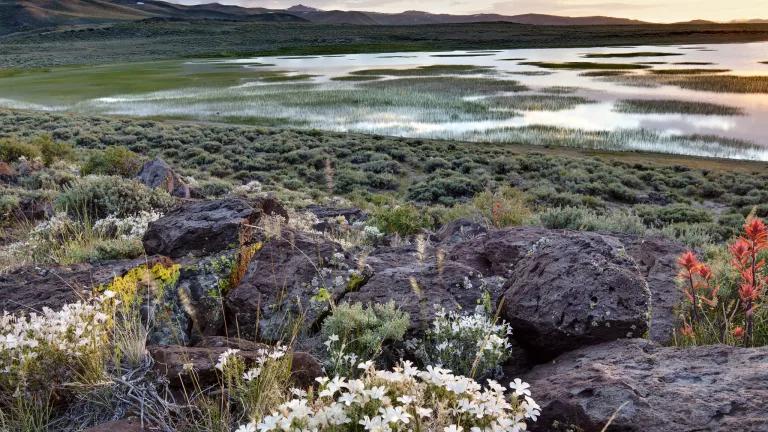The Fight for Our Future Depends on Forests

The health and future of our forests is inextricably tied to our own. While, too often, we view the value of forests through the lens of corporate revenue, this International Day of Forests on March 21st, it’s worth remembering their true worth. Forests around the world, from the great northern boreal to tropical rainforests, breathe life onto our planet and provide everything from clean air and water to a stable climate. If we are going to overcome the immense environmental crises we currently face, we need to recognize that our future depends on protecting our forests.
This International Day of Forests has the theme of Forests and Biodiversity, marking forests’ essential role in harboring 80 percent of the world’s species, including biodiversity riches we don’t even know exist. Tropical forests support at least two-thirds of the world’s biodiversity while covering less than 10 percent of the Earth’s land surface, while the Canadian boreal forest supports species that have disappeared from the rest of North America. This biodiversity also supports communities, as 1.6 billion people depend on forests for their livelihoods.
Yet biodiverse, intact forests also have another essential function: regulating earth’s climate. Forests are the largest contributor to the terrestrial sink, absorbing about 25 percent of our annual greenhouse gas emissions and slowing our impact on the climate. Forests are also carbon sinks, keeping vast stores of carbon locked away in their vegetation and soils. Tropical forests contain about 25 percent of the world’s carbon, while the Amazon basin alone stores up to 140 billion tons. Due to its cold temperatures and acidic soils, the Canadian boreal forest alone contains twice as much carbon as is in the entire world’s oil reserves.
Forests can only maintain this value for the climate if they are left intact. However, around the world, intact forests are being fragmented, clearcut, and degraded in the name of industrial logging, agricultural and cattle operations, mining, and other industrial activities. In Canada, the logging industry clearcuts over a million acres of forests every year to feed global demand for products like toilet paper, newsprint, and lumber. Furthermore, deforestation rates in the nine countries that house the Amazon rainforest are increasing, especially under political regimes such as far-right Brazilian president Jair Bolsonaro.

This loss of intact forests is eroding our best natural ally in the fight against climate change, even as we struggle to lower our fossil fuel emissions. A recent study analyzing the carbon sequestration capacity of the Amazon found that between 2003 and 2016, the Amazon actually emitted more carbon than it absorbed because so many areas of the forest were clearcut or fragmented that more of the carbon stored in the forest was released into the atmosphere than was taken in. Even a regrown forest after a clearcut has only a fraction of its original ability to absorb carbon from the atmosphere. This is especially true when, as is common in both Canada and the Amazon basin, the forest is converted into a fast-growing monoculture plantation. Each year, logging in the Canadian boreal releases as much carbon as the annual emissions of 55 million passenger vehicles.
Ending deforestation and restoring degraded forests is a critical piece to keeping temperature rise below 2 degrees Celsius, yet decision-makers have been slow to take action—some even rolling back protections—and the global marketplace continues to fuel demand for products from these important ecosystems. Here are much-needed steps to combat global intact forest loss:
- Governments must increase monitoring and regulations. Forest impacts are often underreported. In Ontario, for instance, a study recently found that an average of 14 percent of clearcut areas remained barren of trees even decades later, which is fifty times larger than official provincial estimates.
- Countries need to center Indigenous leadership by recognizing their rights to their land as a primary means of protecting our forests and climate. Around the world, lands controlled and managed by Indigenous Peoples are more biodiverse and absorb more carbon. Researchers found that 70 percent of the total carbon emitted from the Amazon between 2003 and 2016 came from areas outside of Indigenous-held land and protected areas. First Nations in the Canadian boreal are also leading the way on protecting and managing the forest.
- The global marketplace, and especially companies in the U.S., must help curb intact forest loss. U.S. toilet paper producers, such as Procter & Gamble, import vast quantities of pulp from the Canadian boreal forest, driving the loss of this climate-critical forest for throwaway toilet paper, which is now more in demand than ever. Consumers are calling on P&G to shift to more sustainable materials like recycled content, which has one-third the climate impact of forest pulp, to reduce their brands’ impact on the boreal and the climate, but P&G has yet take sufficient steps. It is urgent for large companies like P&G to shift the marketplace toward supply chains that do not come at the cost of our forests.
- U.S. state and local governments also need to protect intact forests. Recently, the City Council of Los Angeles unanimously approved a motion to address the city’s contributions to deforestation in the Amazon. The motion also explicitly expresses support for a California state bill, AB 2002 (Kalra), that similarly would prohibit the state from contracting with any company whose activities contribute to deforestation of tropical forests. New York state is considering similar legislative action, and NRDC and others are working to expand to other U.S. cities and states. These policies should be replicated in many more states and municipalities.
The fate of intact forests may seem like a far-away concern as we all face challenges much closer to home. But in these uncertain times, one certainty is the global importance of protecting forests. The health of our forests is inextricably tied to our own; it’s time to look beyond their fleeting value as toilet paper or farmland and protect these forests for generations to come.




